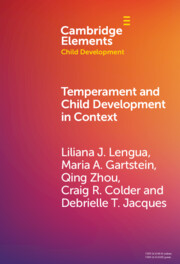Element contents
Temperament and Child Development in Context
Published online by Cambridge University Press: 22 November 2024
Summary
Keywords
- Type
- Element
- Information
- Series: Elements in Child DevelopmentOnline ISBN: 9781009521840Publisher: Cambridge University PressPrint publication: 28 November 2024
References
- 2
- Cited by

